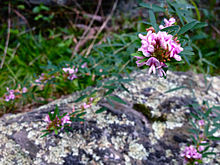Lespedeza virginica
| Lespedeza virginica | |
|---|---|

| |
| In Virginia, United States | |
| Scientific classification | |
| Kingdom: | Plantae |
| Clade: | Tracheophytes |
| Clade: | Angiosperms |
| Clade: | Eudicots |
| Clade: | Rosids |
| Order: | Fabales |
| Family: | Fabaceae |
| Subfamily: | Faboideae |
| Genus: | Lespedeza |
| Species: | L. virginica
|
| Binomial name | |
| Lespedeza virginica | |
| Synonyms[2] | |
|
Synonymy
| |
Lespedeza virginica, known as slender bush clover or slender lespedeza, is a species of flowering plant native to much of the United States, as well as Ontario, Canada,[3] and Nuevo León, Mexico.[4]: 8–9 It is a member of the bean family, Fabaceae.
Description[edit]
Lespedeza virginica is an herbaceous, perennial legume.[5] It can grow to be up to 2.5 feet tall. Slender bush clover has trifoliate compound leaves and slender primary petioles, with the stem covered in small white hairs. Its alternate leaves are dark green, though sometimes appear pale. The flowers are pink and have a broad upper petal with two side petals.[6] Flowers produced are either cleistogamous or chasmogamous.[7] Slender bush clover flowers from July to September and sets seed from September to October.[7] L. virginica grows well in environments with full to partial sun and can grow successfully in rocky or sandy soils. It produces a taproot to assist in establishment.
Distribution and habitat[edit]
Lespedeza virginica is found from Maine south to Florida, west to Texas and north to Michigan as well as in Eastern Canada.[3] L. virginica prefers drier habitats, but can be found in prairies, rocky and sandy forests, savannas and environments with high drainage such as roadsides.[6]
Disjunct populations are found in Nuevo León, Mexico, central Wisconsin and southern Minnesota.[4]: 8–9
Ecology[edit]
Lespedeza virginica is eaten by a wide variety of wildlife. It is a large part of the bobwhite quail's diet as well as deer and other ground birds. The seeds are eaten as well as the leaves. Nectar and pollen are eaten by various long-tongued insects such as butterflies and bees.[6]
Scarification of the testa is reportedly necessary for germination, suggesting that consumption of seeds by animals is important in the plant's life cycle.[4]: 16 [8]
Conservation[edit]
Lespedeza virginica is listed as threatened in Wisconsin[9] and endangered in New Hampshire [10] and Ontario.[11]
L. virginica is an endangered species of Canada under the Species at Risk Act.[12] It is found there only in the Ojibway Prairie Complex in southern Ontario amongst tallgrass prairie and savanna habitats. It is threatened by changes to patterns of habitat disturbance, with lack of requisite open areas, and by competition with invasive species, notably crownvetch.[4]
References[edit]
- ^ NatureServe (1 September 2023). "Lespedeza virginica". NatureServe Network Biodiversity Location Data accessed through NatureServe Explorer. Arlington, Virginia: NatureServe. Retrieved 19 September 2023.
- ^ Lespedeza virginica (L.) Britton. Plants of the World Online. Retrieved 4 September 2023.
- ^ a b Lespedeza virginica. Lady Bird Johnson Wildflower Center. N.p., n.d. Web. 16 Dec. 2014.http://www.wildflower.org/plants/result.php?id_plant=LEVI7
- ^ a b c d COSEWIC (2013). COSEWIC Assessment and Status Report on the Slender Bush-clover Lespedeza virginica in Canada (PDF) (Report). Ottawa: Committee on the Status of Endangered Wildlife in Canada. Retrieved 19 September 2023.
- ^ "Plants Profile for Lespedeza virginica (slender lespedeza)." 16 Dec. 2014.http://plants.usda.gov/core/profile?symbol=levi7
- ^ a b c "Slender Bush Clover (Lespedeza virginica)." 16 Dec. 2014.http://www.illinoiswildflowers.info/savanna/plants/sl_bushclover.htm
- ^ a b Schutzenhofer, Michele R. "The Effect of Herbivory on the Mating System of Congeneric Native and ExoticSpecies." International Journal of Plant Sciences 168.7 (2007): 1021-026. Web.
- ^ Clewell, Andre F. (1966). Natural history, cytology, and isolating mechanisms of the native American Lespedezas. Bulletin of Tall Timbers Research Station. Tallahassee, Florida: Tall Timbers Research Station. LCCN 68000241. No. 6.
- ^ "Slender Bush Clover (Lespedeza virginica) - Wisconsin DNR". dnr.wi.gov.
- ^ "Rare Plant List | Reports | NH Division of Forests and Lands". www.nh.gov.
- ^ "Appendix P: Endangered, threatened and vulnerable species in Ontario". www.ontario.ca.
- ^ "Slender Bush-clover (Lespedeza virginica)". Species at risk public registry. Government of Canada. 13 June 2023. Retrieved 19 September 2023.

